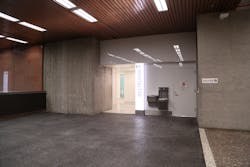John Strom, vice president and general manager of Connected Solutions with GP PRO, said a survey conducted in September 2020 found that 81% of respondents just wanted to get in and out of the restroom. Forty-one percent said they’d altered their schedule or their route to avoid having to use any public restroom, and 43% said they lacked confidence in public restroom cleaning and hygiene practices.
“When we asked them to describe their typical restroom experience in one word, they said things like “dirty,” “nasty” and “smelly,” said Strom. “The pandemic put the spotlight on facility-wide hygiene and its connection to personal health and safety. Since restrooms have historically been the area of public-facing facilities that elicit the most complaints, the pandemic really kind of forced facilities to reconsider what kind of experience users were having and how to elevate it.”
With the help of technology that can monitor restrooms and alert maintenance to low levels of soap, tissues and other necessities, passenger confidence can be stocked up.
“GP PRO’s KOLO Smart Monitoring System is an example of a technology that helps ease these burdens by providing customizable real-time alerts on product levels, dispenser jams, and other maintenance concerns so issues can be addressed before they turn into consumer complaints, and custodial staff can work more efficiently and productively rather than running around checking product levels. The KOLO system also offers a customizable task management system to ensure a wide range of cleaning and maintenance tasks both in and out of the restroom are handled in a timely manner,” said Strom.
The KOLO system runs on an open platform, so not only can it monitor towel, tissue, soap and sanitizer dispensers, but it can monitor other connected systems, too.
“On top of these real-time alerts, the KOLO system also captures historical data, so facility managers can identify which restrooms are the busiest and at what time of day. This helps with custodian scheduling as well as workflow and task management, allowing facility managers to schedule and assign custodial staff based on current and historical data, which can help eliminate staffing redundancies,” he added.
On top of real-time alerts, the KOLO system also captures historical data, so facility managers can identify which restrooms are the busiest and at what time of day. This helps with custodian scheduling as well as workflow and task management, allowing facility managers to schedule and assign custodial staff based on current and historical data, which can help eliminate staffing redundancies.
And GP PRO recently launched a partnership with Butlr Technologies – a spin-out of the MIT Media Lab. They’ve built a people-sensing platform called Heatic that uses thermal, wireless sensors and AI to detect human presence.
“The technology senses body heat to infer the presence of a person. Combining this technology with the KOLO system allows for traffic-based cleaning – cleaning that is performed after a customizable number of individuals have used a restroom. So there’s no cleaning a clean restroom or not cleaning a restroom that desperately needs to be cleaned,” said Strom.
What makes this technology different from a people-counter at the entrance is that where a people-counter can tell you that someone entered the restroom, it can’t tell how they used it.
“If they went into a restroom stall, if they just popped in to wash their hands, or if they simply looked in the mirror and left again. Knowing how individuals are using a restroom complements the data the KOLO system is collating and empowers facility managers to assign staff and cleaning tasks based on how the space has been used
“Understanding exactly how a restroom is being used and by how many individuals, and combining that with real-time product level data, facility managers have real-time and historical information that aids with everything from ordering product to assigning custodial staff to performing routine maintenance checks,” Strom said.
About the Author
Walker Jaroch
Editor
Contact: Walker Jaroch
Editor | AMT
+1-920-568-8399
>> To download the AviationPros media kits, visit: Marketing Resource Center
>>Check out our aviation magazines: Ground Support Worldwide | Airport Business | Aircraft Maintenance Technology
Joe Petrie
Editor & Chief
Joe Petrie is the Editorial Director for the Endeavor Aviation Group.
Joe has spent the past 20 years writing about the most cutting-edge topics related to transportation and policy in a variety of sectors with an emphasis on transportation issues for the past 15 years.
Contact: Joe Petrie
Editor & Chief | Airport Business
+1-920-568-8399
>> To download the AviationPros media kits, visit: Marketing Resource Center
>>Check out our aviation magazines: Ground Support Worldwide | Airport Business | Aircraft Maintenance Technology


